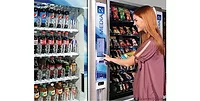Technology, healthier options drive vending industry
Consumer engagement, connectivity impact vending

In response to consumers seeking healthier options, vending machines now stock a broader food and beverage portfolio along with the “smart” technological solutions like Apple Pay and Google Pay. On-machine signage also is helping consumers to better evaluate their choices.
Although the vending machine operators industry has struggled during the past decade, in the five years to 2016, “revenue decreased at an annualized rate of only 0.2 percent to an estimated $6.7 billion, with a 0.2 percent decrease in 2016,” states Los Angeles-based IBISWorld in its December 2016 report titled “Vending Machine Operators in the US.”
It also highlights the decreased per capita consumption of carbonated soft drinks; a rise in the healthy eating index, which measures the percentage of a recommended diet that an average American eats; and more per capita disposable income as key trends. “Additionally, a change in product mix toward heathier snacks, beverages and other food items, along with increasing use of technology helped companies spur demand,” it states.
The healthier product selection is a key driver of the vending platform. As a result, Purchase, N.Y.-based PepsiCo Inc. launched its Hello Goodness vending platform in December 2015 to meet consumers’ evolving needs, says David Lothian, vending sales and senior director of strategy for PepsiCo Foodservice.
“There will always be consumers who are looking for a treat but, for example, we know that nearly two-thirds of consumers don’t use vending today because, for many of them, historically, there haven’t been healthier choices available,” he says. “That is changing. PepsiCo’s Hello Goodness vending platform combines our broad food and beverage portfolio to offer consumers a variety of healthier choices throughout the day — everything from Quaker Breakfast Flats and Tropicana Pure Premium Orange Juice in the morning … to Naked Juice or Sabra Hummus and Pretzels as an afternoon snack.”
More than 24,000 Hello Goodness units are in operation at a variety of locations, including hotels, college campuses and city tourist sites, he adds.
In addition to healthier options, vending machines have had to keep pace with technology and the proliferation of package sizes and shapes, says Chuck Reed, vice president and general manager of vending at Crane Payment Innovations, Malvern, Pa.
“The machine [original equipment manufacturers] (OEMs) are faced with engineering new dispensing solutions regularly,” he says. “The use of connectivity solutions is the advancement most sought by vending operators. A vending machine that is ‘connected’ enables more efficient operations to service the machine, consumer engagement with promotions and loyalty programs, and cashless acceptance is impacting the industry.”
PepsiCo’s Lothian also points to this trend. “Technology has significantly increased engagement and elevated the vending experience,” he says. “The Hello Goodness vending experience mirrors consumers’ everyday ‘smart’ experience by incorporating digital touchscreens on the equipment, mobile payment methods — such as Apple Pay and Google Pay — as well as the ability to suggest product purchase pairings and to build baskets.”
More variety and additional distribution points beyond traditional brick-and-mortar stores also are key trends, says Gary Hemphill, managing director of research for the New York-based Beverage Marketing Corporation (BMC).
“Vending generally lags the market when it comes to innovation due to the limited number of product offerings any one machine can hold. That said, we are seeing a greater array of beverages placed in today’s machines,” Hemphill says. “… Venders are crucial to the industry because so many beverage purchases are impulse driven and are great for capturing impulse purchases often at a premium price.”
Crane Payment’s Reed adds: “Vending is very important to beverage companies. Vending enables companies to test various new product ideas in targeted campaigns. Vending also is their only retail channel with everything else sold through traditional distribution channels. Beverage companies are now deploying software that improves their profitability. Many companies are reporting moving from an operating loss to an operating profit as a result.”
Although healthier products have been introduced, they are not likely to propel the vending industry into new high-growth cycles, IBISWorld’s report states. The market research firm projects that industry revenue will decline at an annualized rate of 0.3 percent to $6.6 billion during the five years to 2021.
Yet, experts note that the addition of cashless acceptance, programs that communicate advertisements and promotions, more energy-efficient systems, and the creation of the next-generation of vending equipment could drive higher sales.
“PepsiCo is exploring multiple paths to expand the footprint of Hello Goodness beyond vending to find new ways to provide convenient, affordable and great-tasting, healthier options for consumers,” Lothian says. “Additionally, PepsiCo is looking toward the future to design the next-generation of vending equipment to accommodate consumer preferences related to functional design and overall experience … such as dispensing product via a raised dispense point so that consumers don’t have to bend over.” BI
Looking for a reprint of this article?
From high-res PDFs to custom plaques, order your copy today!




